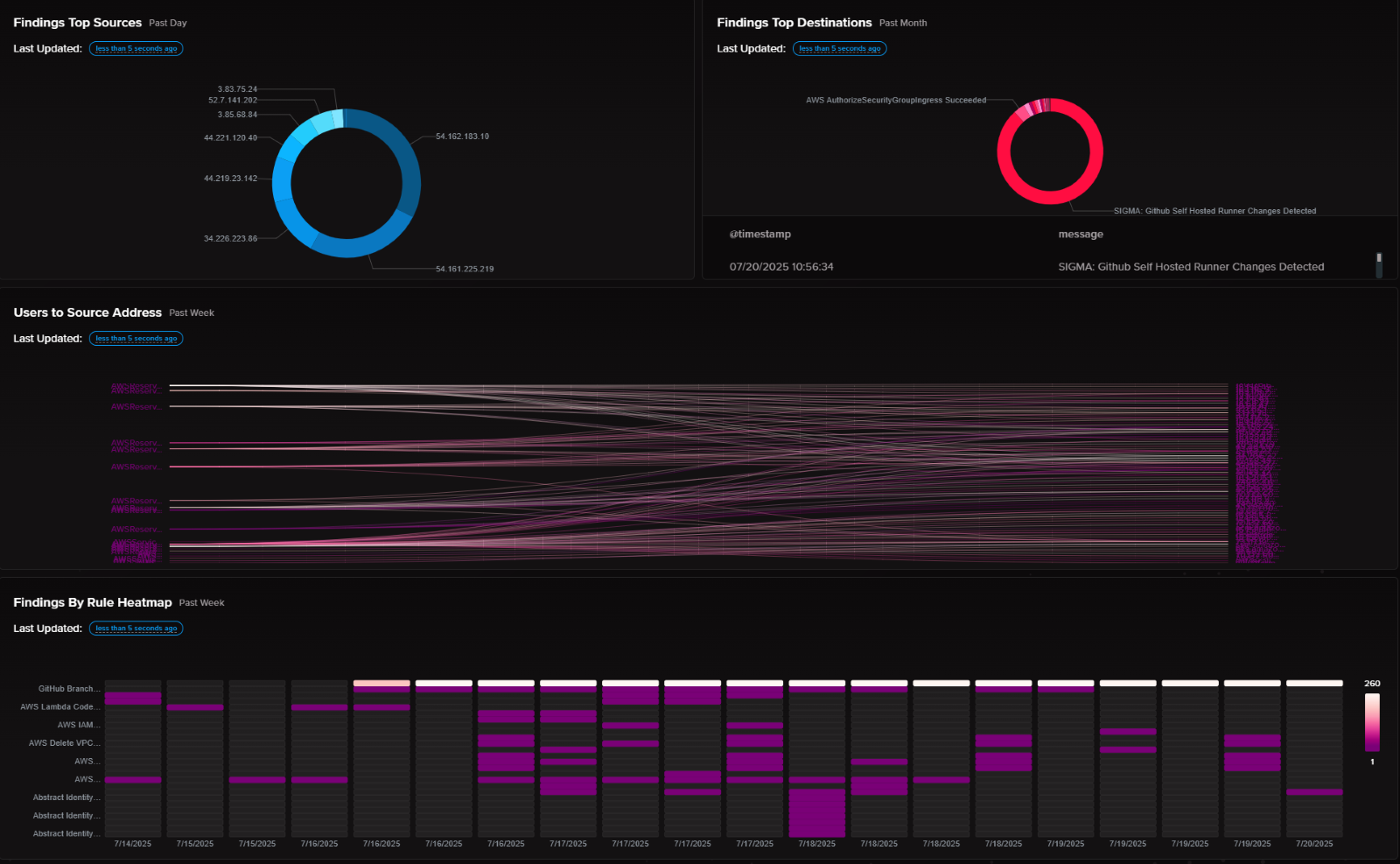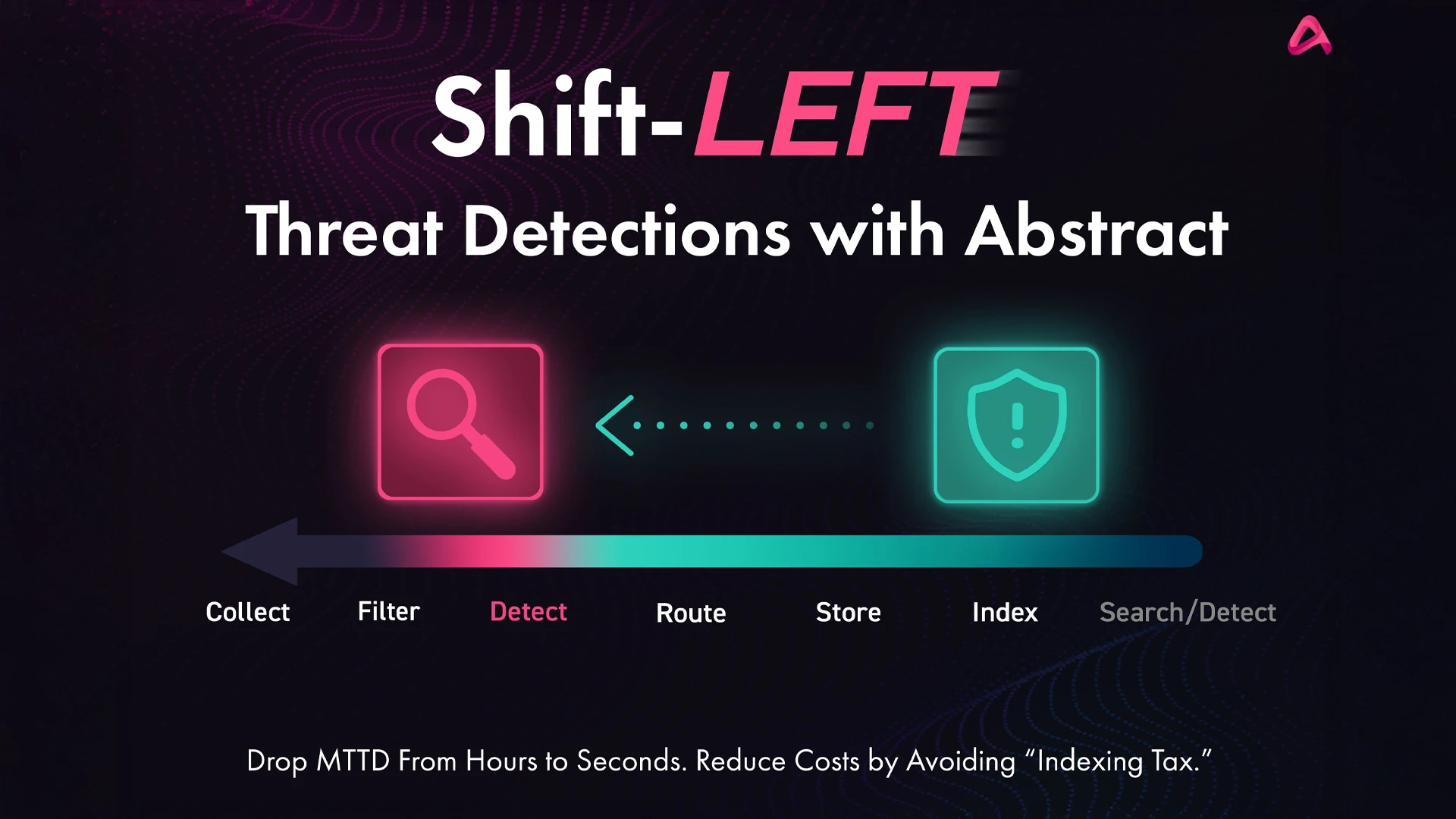A note from the Author, CEO and Co-Founder Colby DeRodeff
I’ve been building security analytics platforms for over two decades, starting as one of the early employees at ArcSight in 2001. Back then, we were solving how to centralize detection and security data at scale. But today’s problem is different: the data is bigger, faster, and more distributed. The SIEM Market has drifted from real-time to a post index world—and waiting to detect threats after data is stored simply doesn’t cut it.
At Abstract, we’ve built our platform around a different principle: move detection into the stream. I’ve always believed the best security outcomes come from reacting in real time, not after the fact. That’s why Shift-Left is the design philosophy we started with and the reason customers come to us today and the reason I wrote this paper to share our vision. Let’s continue our mission to “Detect and stop adversaries who threaten our collective livelihood!”
Shift-Left Detections with Abstract: Streaming Analytics for Faster Detection and Response
Security teams today don’t lack data—they are overwhelmed by it. As telemetry volumes increase from SaaS platforms, cloud infrastructure, endpoints, and security controls, the challenge isn’t collecting information—it’s acting on it in time. Traditional detection pipelines, which rely on post-ingest analytics within SIEMs or data lakes, are proving too slow, too expensive, and too disconnected to meet the demands of modern security operations.

Most SIEM platforms detect threats hours after the relevant events have occurred, a direct result of their legacy architectures. Detection logic is often applied only after data has been normalized, indexed, and stored—an inherently delayed process built on monolithic infrastructure that cannot keep pace with real-time security demands.

This delay is not just operationally inefficient—it is strategically dangerous. According to CrowdStrike, the average adversary breakout time is 43 minutes, meaning attackers often move laterally within the environment faster than traditional systems can even process the telemetry. In this context, every minute of delay increases the defender’s disadvantage and narrows the response window.
Abstract is the only data pipeline platform with a built-in, streaming correlation engine designed specifically for security operations. While others offer basic filtering or static enrichment, Abstract performs real-time correlation, contextual enrichment, and detection in-stream—before the data reaches any destination. This enables organizations to identify threats while they are still unfolding, not after the fact.
With Shift-Left, detection becomes proactive rather than reactive. The outcome is not simply faster alerts—it is fundamentally earlier intervention.
This is why we were founded with the philosophy of Shift-Left.
At Abstract, Shift-Left means moving detection closer to the source—executing analytics in the data stream itself before the data ever reaches its final destination.

Picture your SOC seeing an account hijack attempt tied to a known malicious IP and being able to blocking it before the logs even land in a traditional data lake? This architectural approach improves mean time to detection (MTTD) and mean time to response (MTTR) by eliminating delays introduced by legacy processing stages. Instead of waiting for data to land in storage, normalize, enrich, and index, Abstract evaluates events as they move, enabling live decision-making.
At Abstract, Shift-Left means moving detection closer to the source—executing analytics in the data stream itself before the data ever reaches its final destination. Picture your SOC seeing an account hijack attempt tied to a known malicious IP and being able to blocking it before the logs even land in a traditional data lake? This architectural approach improves mean time to detection (MTTD) and mean time to response (MTTR) by eliminating delays introduced by legacy processing stages. Instead of waiting for data to land in storage, normalize, enrich, and index, Abstract evaluates events as they move, enabling live decision-making.
True Streaming Correlation, Built-In from the Start
While some vendors offer “stream processing” as a bolt-on or rely on static enrichment lookups, Abstract’s streaming analytics engine was designed from the ground up to perform real-time correlation across diverse data sources. This includes:
- Threat intelligence that is treated as a live, contextual input—not just static map files or offline reference lists.
- Asset and identity data that is integrated directly into the pipeline, enabling identity correlation across fragmented log sources (e.g., endpoint, cloud, SaaS).
- Detection rules that operate continuously in the stream, allowing for instant alerting and response logic before any data lands in a SIEM or data lake.
This is not enrichment as an afterthought. It is a unified model where context travels with the data, enabling richer detection outcomes with significantly lower latency.
Why It Matters
Traditional models wait until telemetry is stored and indexed before analysis begins. This introduces delays, raises costs, and often requires complex reprocessing workflows to update detection coverage. With Shift-Left, Abstract eliminates that overhead. Rules are evaluated at the moment of data transit, enriched with full context, and executed in real time.
The result is not just faster alerts. It’s better alerts, grounded in live asset and identity context, and delivered before threats have time to spread.

Shift-Left, Stay Ahead
By embedding intelligence directly into the data stream, Abstract provides security teams with earlier insight, broader coverage, and faster resolution—without the operational weight of legacy platforms. ‘Shift-Left’ isn’t a feature—it’s a foundational shift in how detection should work.
What Correlation Really Means in Security Analytics
Correlation is one of the most overused and least understood terms in cybersecurity. In traditional SIEM architectures, it often refers to matching static fields—such as an IP address or username—across datasets after ingestion. This approach is brittle, delayed, and limited in its ability to handle context, time, or relationships between events.

At Abstract, correlation is not a search—it is a real-time, resident analytical process that operates within the stream. Our platform performs joins across multiple, disparate log sources as data arrives. This allows us to construct meaningful relationships between events that may originate in entirely different systems: endpoint logs, cloud audit trails, identity providers, threat intelligence feeds, and more.
For example:
- A login attempt from a suspicious IP address (CloudTrail)
- Followed by a file download from a managed device (EDR)
- Attributed to an identity that recently failed MFA (SSO)
In traditional pipelines, these events would be stored separately, normalized independently, and eventually queried through scheduled correlation jobs or manual investigation. By contrast, Abstract can correlate these events in-stream, applying detection logic across all of them within a bounded time window—often milliseconds from the moment the last event is received.
This includes:
- Temporal joins, where rules evaluate conditions across time (e.g., “X must follow Y within 5 minutes”)
- Cross-source identity resolution, tying together usernames, hostnames, device IDs, and session tokens across systems
- Multi-condition pattern recognition, where composite rules are evaluated as logical chains, not isolated triggers
The result is a system capable of identifying behavior, not just events. This allows security teams to detect threats earlier, with greater accuracy, and without the cost or delay of retroactive queries.

Correlation at Abstract is not a feature layered on top—it is a native capability of the streaming engine itself. It allows us to ask smarter questions, at the right time, using the full context of your environment.
Complementing Abstract’s real-time analytics architecture is the work of our ASTRO team—a dedicated group of detection engineers, threat researchers, and adversary simulation experts. The ASTRO team is responsible for delivering a continuously updated library of pre-built detection rules, numbering in the thousands, that are tuned for streaming execution across diverse log sources. In addition to rule content, the team produces Abstract’s proprietary threat intelligence feed, which is directly integrated into the correlation engine—not as static reference files, but as a dynamic, first-class data source. This allows organizations to deploy high-confidence, context-aware detections immediately, without the overhead of building custom content or sourcing external enrichment pipelines.
Offloading Detection Logic from the SIEM
One of the most immediate and measurable benefits of shifting analytics into the stream is the ability to offload detection logic from the SIEM entirely.
In traditional environments, SIEM platforms serve as both the data store and the detection engine. This forces organizations to ingest vast volumes of telemetry simply to apply detection rules—driving up licensing costs, straining performance, and locking teams into rigid vendor ecosystems.
Abstract breaks this dependency. By supporting stream-based detection, organizations can move their existing SIEM rules into the data pipeline itself. These rules are evaluated as data flows through the stream, enriched with context, and correlated across sources—all before reaching any destination.
As a result:
- Only alerts and minimal supporting data are forwarded to the SIEM, dramatically reducing ingestion volume and associated cost.
- The full-fidelity data remains available in LakeVilla for search, replay, and long-term retention—without needing to store everything in hot SIEM storage.
- Security teams retain full control over detection logic and data handling, independent of the SIEM vendor’s roadmap or pricing model.
This architecture introduces strategic flexibility. Instead of being locked into a single SIEM platform—or paying to rehydrate and reprocess data during a migration—organizations can evolve their tooling over time. With Abstract at the center, the detection layer becomes portable, and decisions about storage, search, or response tooling can be made based on operational need, not architectural constraint.
The SIEM becomes just one possible destination, no longer the foundation.
Shift Left Detections and Get Abstracted!



